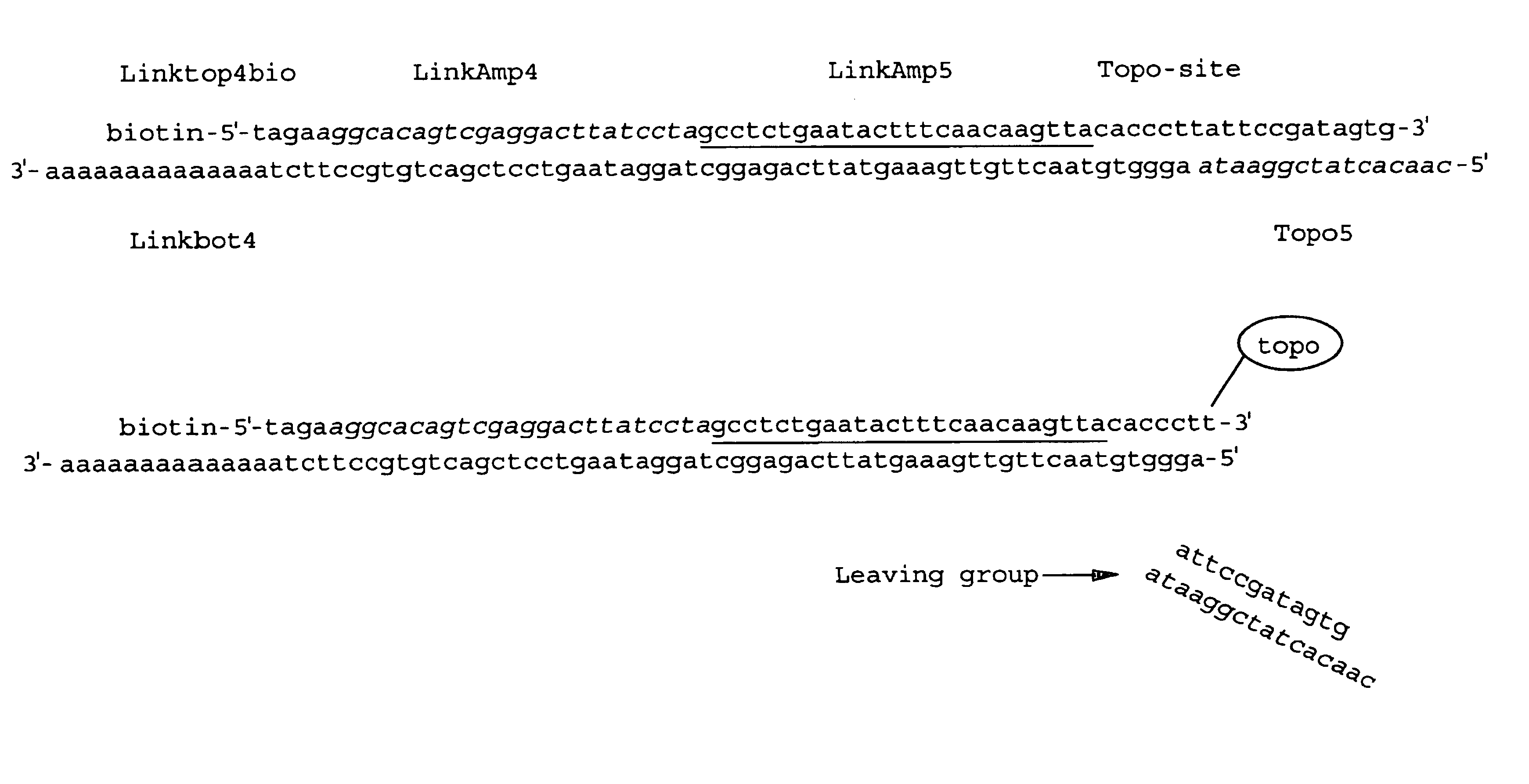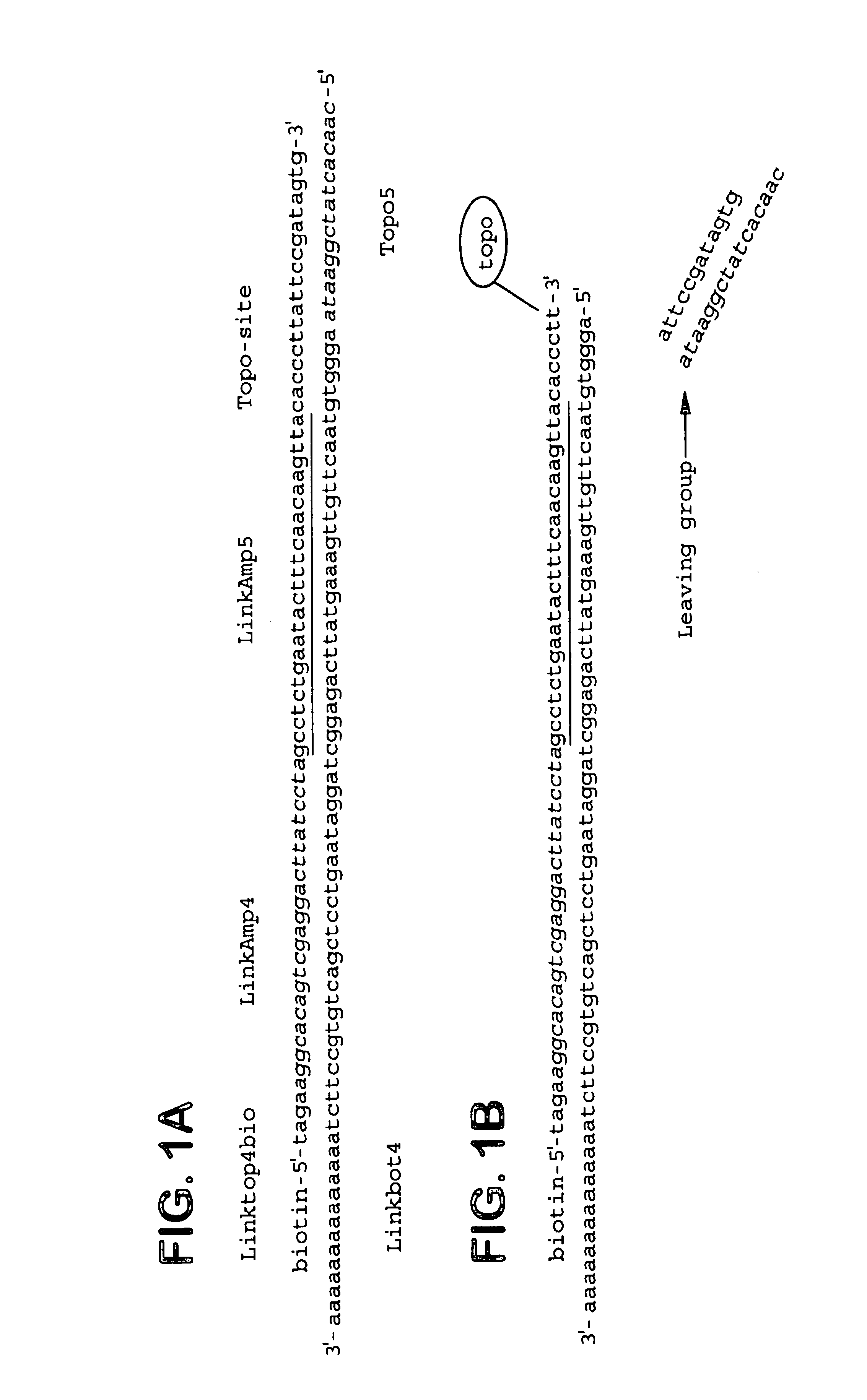Topoisomerase linker-mediated amplification methods
a technology of linker-mediated amplification and topoisomerase, which is applied in the field of isolating and sequencing nucleic acid sequences, can solve the problems of inability to make complementary oligos, inability to perform standard pcr, and inability to contiguously sequence a long dna strand such as a chromosome, and achieve the results of a gel pattern obtained by the “primer-walking” method that is impossibl
- Summary
- Abstract
- Description
- Claims
- Application Information
AI Technical Summary
Benefits of technology
Problems solved by technology
Method used
Image
Examples
example 1
Preparation Of A Double-Stranded Topoisomerase I Adapted Linker
A. Oligos Used to Prepare Pro-linker:
Linktop4bio
[0069]5′-TAGAAGGCACAGTCGAGGACTTATCCTAGCCTCTGAATACTTTC AACAAGTTACACCCTTATTCCGATAGTG (SEQ ID NO: 2). This oligo contains the Vaccinia Topoisomerase I cleavage site (in bold) and is biotinylated at the 5′ end. The biotin prevents the 5′ end of the oligo from being a substrate for Topo-mediated end-joining. In addition, the biotin modification facilitates reverse-phase chromatography oligo purification, eliminating the need for more costly gel purification. The biotin group may also be useful in purifying the linked product before PCR.
Linkbot4
[0070]5′-p-AGGGTGTAACTTGTTGAAAGTATTCAGAGGCTAGGATAAGTCC TCGACTGTGCCTTCTAAAAAAAAAAAAAA (SEQ ID NO: 3). This oligo is phosphorylated at the 5′ end to ensure that it will not be a substrate for topoisomerase-mediated DNA end-joining. The polyA stretch has been shown to bind oligodT cellulose which may provide additional uses in separation of t...
example 2
[0117]This assay demonstrates that the diluted topoisomerase-linker joins to the A-overhang produced by a sequence-specific Taq-mediated primer extension of PstI-digested Lambda DNA.
A. Sequence-specific Primer Extension of PstI-cut Lambda DNA
[0118]1. Preparation of a Polynucleotide Segment from a Vector Clone
[0119]A Lambda vector containing a DNA insert was cut to completion with PstI and the cut DNA fragment was dephosphorylated using the following reaction mixture:[0120]2 μg PstI-cut Lambda DNA (Sigma)[0121]5 μl (5 units) calf intestinal phosphatase (CIP)(Roche)[0122]5 μl 10×dephosphorylation buffer (Roche)[0123]dH2O to 50 μl
The reaction mixture was incubated 1 h at 37° C. to obtain a dephosphorylated fragment containing insert DNA of unknown sequence
[0124]2. The PstI Cut Dephosphorylated Fragment was Extracted with Phenol and Precipitated as Follows:[0125]1. Add 50 μl dH2O[0126]2. Add 50 μl phenol (Sigma) and vortex at full power for 10 seconds.[0127]3. Centrifuge at full speed i...
example 3
A. BAC DNA Primer Extension:
[0146]The bacterial artificial chromosome used here is BAC 327L24. This artificial chromosome vector contains a 170 kb human DNA insert cloned into the EcoRI site of the pBAC3.6e backbone. DNA digestion cocktail: 1.7 μg DNA, 40 units PstI (NEB), 4 μl NEB restriction buffer 3, dH2O to 40 μl final volume. This mixture was incubated at 37° C. for 2 hr and then the enzyme was heat inactivated by 20 min incubation at 80° C. Subsequently, 4 μl calf intestine phosphatase (CIP) (Roche), 6 μl 10×phosphatase buffer (Roche), and 50 μl dH2O were added and the mixture was incubated 1 hr at 37° C., then phenol extracted, precipitated, washed with 80% ethanol, dried, and resuspended to a concentration of 40 ng / μl (assuming complete DNA recovery).
[0147]120 ng of this cut and dephosphorylated DNA was used as template in a primer extension reaction performed as described above for Lambda DNA except that primer sequence-specific to the bacterial artificial chromosome vector...
PUM
| Property | Measurement | Unit |
|---|---|---|
| melting temperature | aaaaa | aaaaa |
| temperature | aaaaa | aaaaa |
| volume | aaaaa | aaaaa |
Abstract
Description
Claims
Application Information
 Login to View More
Login to View More - R&D
- Intellectual Property
- Life Sciences
- Materials
- Tech Scout
- Unparalleled Data Quality
- Higher Quality Content
- 60% Fewer Hallucinations
Browse by: Latest US Patents, China's latest patents, Technical Efficacy Thesaurus, Application Domain, Technology Topic, Popular Technical Reports.
© 2025 PatSnap. All rights reserved.Legal|Privacy policy|Modern Slavery Act Transparency Statement|Sitemap|About US| Contact US: help@patsnap.com


